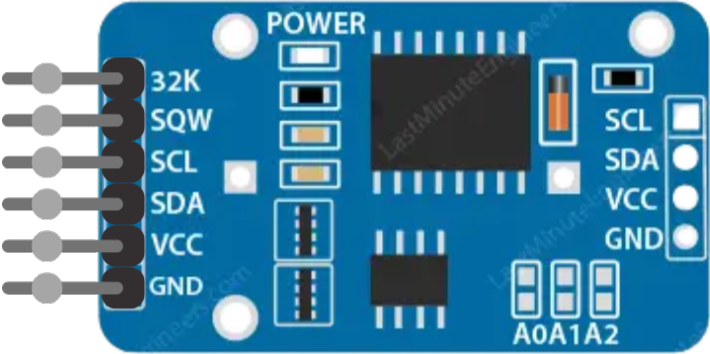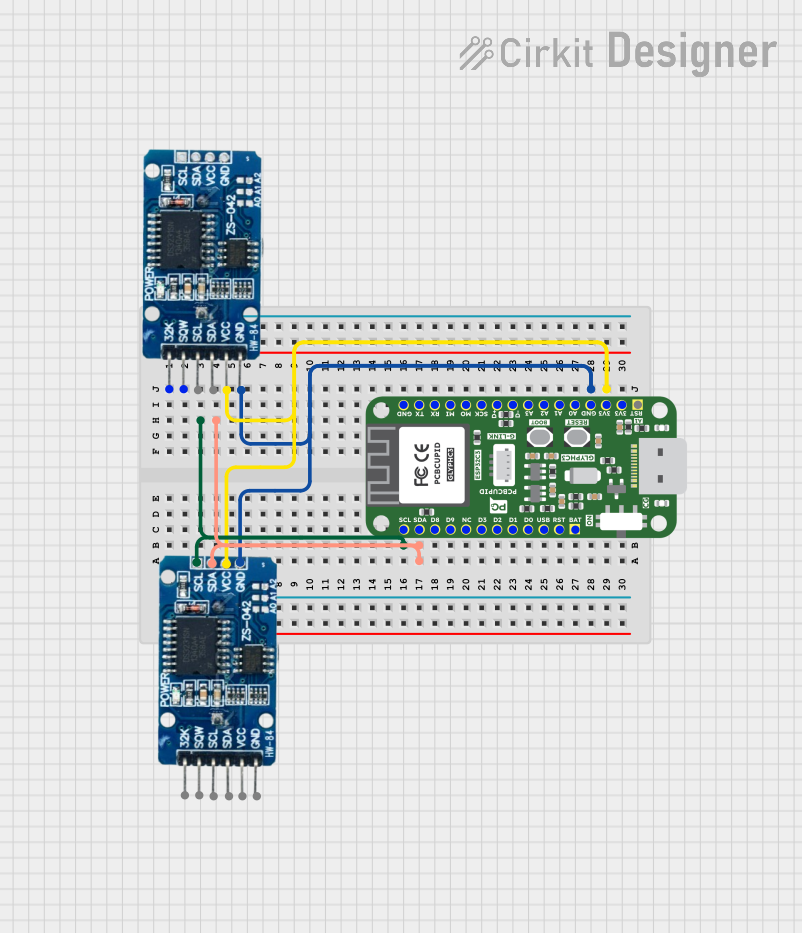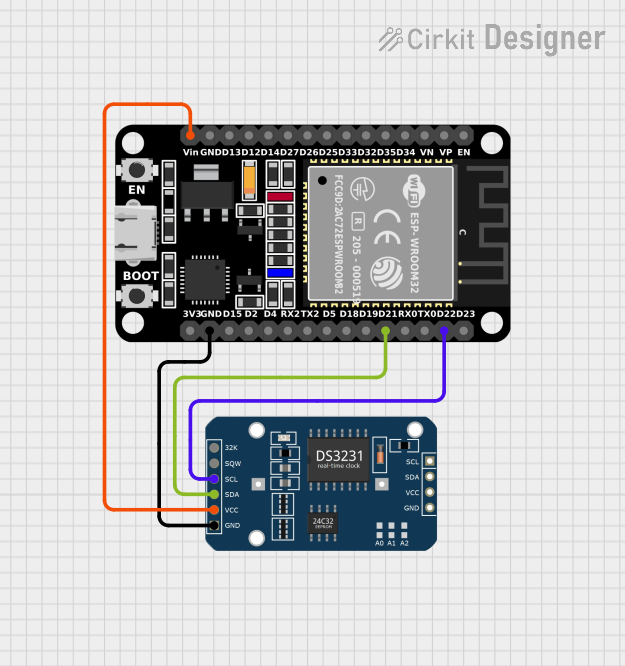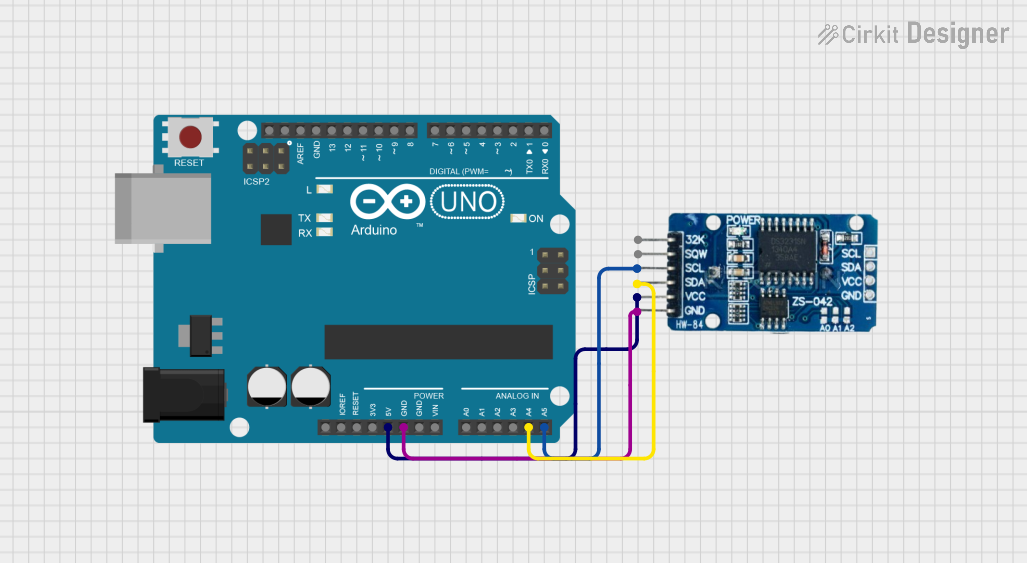
How to Use DS3231 RTC: Examples, Pinouts, and Specs

 Design with DS3231 RTC in Cirkit Designer
Design with DS3231 RTC in Cirkit DesignerIntroduction
The DS3231 is a highly accurate real-time clock (RTC) module designed to keep track of the current time and date. It features a temperature-compensated crystal oscillator (TCXO) to ensure high precision, even under varying environmental conditions. The module communicates with microcontrollers via an I2C interface, making it easy to integrate into a wide range of projects.
Explore Projects Built with DS3231 RTC

 Open Project in Cirkit Designer
Open Project in Cirkit Designer
 Open Project in Cirkit Designer
Open Project in Cirkit Designer
 Open Project in Cirkit Designer
Open Project in Cirkit Designer
 Open Project in Cirkit Designer
Open Project in Cirkit DesignerExplore Projects Built with DS3231 RTC

 Open Project in Cirkit Designer
Open Project in Cirkit Designer
 Open Project in Cirkit Designer
Open Project in Cirkit Designer
 Open Project in Cirkit Designer
Open Project in Cirkit Designer
 Open Project in Cirkit Designer
Open Project in Cirkit DesignerCommon Applications and Use Cases
- Timekeeping in embedded systems
- Data logging with timestamps
- Alarm systems and event scheduling
- Home automation and IoT devices
- Calendar-based applications
Technical Specifications
The DS3231 RTC module is designed for precision and ease of use. Below are its key technical details:
Key Technical Details
- Operating Voltage: 2.3V to 5.5V
- Current Consumption: 1.5 µA (battery backup mode)
- Timekeeping Accuracy: ±2 ppm (±0.1728 seconds/day) from 0°C to +40°C
- Interface: I2C (up to 400 kHz)
- Temperature Range: -40°C to +85°C
- Backup Battery Support: CR2032 coin cell (not included)
- Built-in Oscillator: Temperature-compensated crystal oscillator (TCXO)
- Additional Features:
- Two programmable alarms
- 32 kHz output pin
- Built-in temperature sensor (±3°C accuracy)
Pin Configuration and Descriptions
The DS3231 module typically has 6 pins. Below is the pinout and description:
| Pin | Name | Description |
|---|---|---|
| 1 | GND | Ground connection |
| 2 | VCC | Power supply (2.3V to 5.5V) |
| 3 | SDA | I2C data line (connect to microcontroller's SDA pin) |
| 4 | SCL | I2C clock line (connect to microcontroller's SCL pin) |
| 5 | 32K | Optional 32 kHz output (can be used for external clocking) |
| 6 | SQW | Square wave output or interrupt output (programmable via I2C commands) |
Usage Instructions
The DS3231 RTC module is straightforward to use in a circuit. Below are the steps and best practices for integrating it into your project.
How to Use the DS3231 in a Circuit
- Power the Module: Connect the
VCCpin to a 3.3V or 5V power source and theGNDpin to ground. - Connect I2C Lines:
- Connect the
SDApin to the SDA pin of your microcontroller. - Connect the
SCLpin to the SCL pin of your microcontroller.
- Connect the
- Optional Connections:
- Use the
32Kpin if you need a 32 kHz clock signal. - Use the
SQWpin for alarms or square wave output.
- Use the
- Install a Backup Battery: Insert a CR2032 coin cell battery into the module's battery holder to maintain timekeeping during power loss.
Important Considerations and Best Practices
- Use pull-up resistors (typically 4.7 kΩ) on the SDA and SCL lines if your microcontroller does not have internal pull-ups.
- Avoid exposing the module to extreme temperatures to maintain accuracy.
- Ensure the backup battery is installed correctly to prevent time loss during power interruptions.
- Use libraries like the Arduino
RTClibto simplify communication with the module.
Example Code for Arduino UNO
Below is an example of how to use the DS3231 with an Arduino UNO to read the current time and date:
#include <Wire.h>
#include "RTClib.h"
// Create an RTC_DS3231 object to interact with the DS3231 module
RTC_DS3231 rtc;
void setup() {
Serial.begin(9600); // Initialize serial communication at 9600 baud
Wire.begin(); // Initialize I2C communication
if (!rtc.begin()) {
// Check if the RTC module is connected and working
Serial.println("Couldn't find RTC");
while (1); // Halt the program if the RTC is not found
}
if (rtc.lostPower()) {
// Check if the RTC lost power and set the time if necessary
Serial.println("RTC lost power, setting the time!");
rtc.adjust(DateTime(F(__DATE__), F(__TIME__)));
// Sets the RTC to the date & time when the sketch was compiled
}
}
void loop() {
DateTime now = rtc.now(); // Get the current date and time
// Print the current date and time to the Serial Monitor
Serial.print(now.year(), DEC);
Serial.print('/');
Serial.print(now.month(), DEC);
Serial.print('/');
Serial.print(now.day(), DEC);
Serial.print(" ");
Serial.print(now.hour(), DEC);
Serial.print(':');
Serial.print(now.minute(), DEC);
Serial.print(':');
Serial.print(now.second(), DEC);
Serial.println();
delay(1000); // Wait for 1 second before updating the time
}
Troubleshooting and FAQs
Common Issues and Solutions
RTC Not Detected:
- Cause: Incorrect wiring or missing pull-up resistors on the I2C lines.
- Solution: Double-check the connections and ensure SDA and SCL lines have pull-up resistors.
Incorrect Time or Date:
- Cause: RTC lost power or was not initialized properly.
- Solution: Use the
rtc.adjust()function to set the correct time and date.
Inconsistent Timekeeping:
- Cause: Extreme temperatures or a faulty backup battery.
- Solution: Replace the backup battery and ensure the module is used within its operating temperature range.
No Output on SQW Pin:
- Cause: SQW output not configured.
- Solution: Use I2C commands to configure the square wave output frequency.
FAQs
Q: Can the DS3231 work without a backup battery?
A: Yes, but it will lose the time and date settings if the main power is disconnected.Q: What is the default I2C address of the DS3231?
A: The default I2C address is0x68.Q: Can I use the DS3231 with a 3.3V microcontroller?
A: Yes, the DS3231 is compatible with both 3.3V and 5V systems.Q: How accurate is the DS3231?
A: The DS3231 has an accuracy of ±2 ppm, which translates to a drift of about ±1 minute per year under typical conditions.
By following this documentation, you can effectively integrate the DS3231 RTC module into your projects and troubleshoot common issues.